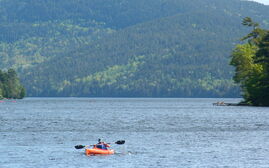UMaine launches workforce training program for offshore wind industry
 SCREENSHOT / COURTESY, MAINE DEPARTMENT OF TRANSPORTATION
The University of Maine is launching a training program for the offshore wind industry. From left in this illustration, a spar foundation, semi-submersible and a tension platform are examples of floating wind turbine foundations. Maine is looking at semi-submersible foundations.
SCREENSHOT / COURTESY, MAINE DEPARTMENT OF TRANSPORTATION
The University of Maine is launching a training program for the offshore wind industry. From left in this illustration, a spar foundation, semi-submersible and a tension platform are examples of floating wind turbine foundations. Maine is looking at semi-submersible foundations.
The University of Maine said it is launching a program to train workers for the offshore wind industry.
The program will include new courses, micro-credentials and an undergraduate concentration in offshore wind energy.
The program was made possible with a $266,669 award from the Governor’s Energy Office’s Clean Energy Partnership program.
Called OffshoreWind4Maine, the program will be led by Amrit Verma, assistant professor of mechanical engineering. It offers hands-on curricula to give high school and UMaine students and working professionals knowledge and skills in the growing industry.
The new offerings are expected to benefit more than 300 undergraduate and graduate students in a single year.
OffshoreWind4Maine will be designed to integrate with Maine’s goals for the production of floating offshore wind energy in the Gulf of Maine. The program will address local energy needs, reduce impacts on the climate and create economic opportunity through Maine-based manufacturing, operations and maintenance of floating turbines.
The state’s strategy is detailed as part of the Maine Offshore Wind Initiative, and the development strategy underway is part of the Maine Offshore Wind Road Map.
The road map team recently completed a 2022 Maine offshore wind talent analysis, which informs and supports the creation of the OffshoreWind4Maine initiative.
The talent analysis, published in July, said Maine has the potential to develop a world-class offshore wind workforce capable of operating regionally, nationally and internationally, including training capacity for wind-specific certifications and for related occupations such as welding, electricians and manufacturing necessary for offshore wind.
The analysis stemmed from Gov. Janet Mills’s stated goals of creating 30,000 clean energy jobs in Maine by 2030 and becoming carbon-neutral by 2045.
The state of Maine is officially bullish about offshore wind-power development, as Mills and her administration study possible uses of the renewable energy at the state's commercial ports and pursue a lease in federal waters for a pilot project.
Maine fishermen, however, have expressed concern about the potential effects of offshore wind power on their industry and earlier this year told officials with the U.S. Department of the Interior's Bureau of Ocean Management that commercial leasing in the Gulf of Maine should be slowed until there’s more research on the interaction between the two industries.
The federal government seeks to support the creation of 77,000 jobs in offshore wind energy as part of its effort to install 30 gigawatts by 2030 and 110 gigawatts by 2050, which would include 15 gigawatts of floating offshore wind energy by 2035.
Verma said employers struggle to find workers in the U.S. with the necessary skills, prompting them to recruit talent from elsewhere. At the same time, the number of UMaine students interested in studying offshore wind energy is growing, with the graduate-level concentration one of the most popular offered by the Department of Mechanical Engineering, he said.
Implementation of the new programs and is a joint effort between the Department of Mechanical Engineering, the UMaine Advanced Structures and Composites Center and the School of Marine Sciences.
The $266,669 award also will provide curriculum development through the Windstorm Challenge, an engineering design competition for Maine middle and high school students to design a floating offshore wind hull and test it at the UMaine Advanced Structures and Composites Center on May 12, 2023.
New micro-credentials will include offshore wind model testing, lab instrumentation, protected species observation and remotely operated vehicle utilization. Students can become certified in offshore wind industry, research and development, and environmental impacts analysis.
The new courses include a graduate-level Wind Energy Engineering course, an Offshore Wind Farm Engineering course for undergraduate and graduate students, a Marine Operations class about building and installing offshore wind technology and the interdisciplinary course Offshore Wind Energy Stakeholder Challenges.
With the new and existing classes, the Department of Mechanical Engineering will be able to create an undergraduate concentration in offshore wind energy, complementing the one currently available for graduate students.
University of Maine is leading a floating offshore wind technology demonstration project, called VolturnUS, that in 2020 received $100 million in investments from Diamond Offshore Wind, a subsidiary of the Mitsubishi Corporation, and RWE Renewables. The partnership between the three entities is called New England Aqua Ventus LLC.
The goal is to develop an 11-megawatt demonstration project using the composite center’s floating platform technology.
The composite center launched the floating offshore wind research program 14 years ago. In 2013, the center launched the 1:8 scale VolturnUS floating hull off Castine as the first grid-connected U.S. offshore wind turbine.
“Today, this program houses one the largest floating offshore wind research and engineering teams in the world,” said Habib Dagher, founding director of the composite center.
Verma said the training program will complement the project and the state’s effort to develop a 150-megawatt floating offshore wind research array, which also will use the composite center’s technology.
“As a result of our cutting-edge research, we have made several advances in the field of offshore wind,” said Verma.
In Maine, offshore wind energy represents the largest untapped natural energy resource, with more than 156 gigawatts, or 156,000 megawatts, of clean power off the coast from the Gulf of Maine’s high-quality offshore wind resource.
Mainers currently use 2.4 gigawatts of electricity each year and New England population centers with high electrical demand are nearby.
Maine has the deepest waters near its shores, approximately 200 feet deep at three nautical miles, and 89% of Maine’s 156 gigawatts offshore wind resource is in deep waters. The state also offers extensive maritime industry infrastructure and proximity to one of the largest energy markets in the country.














0 Comments